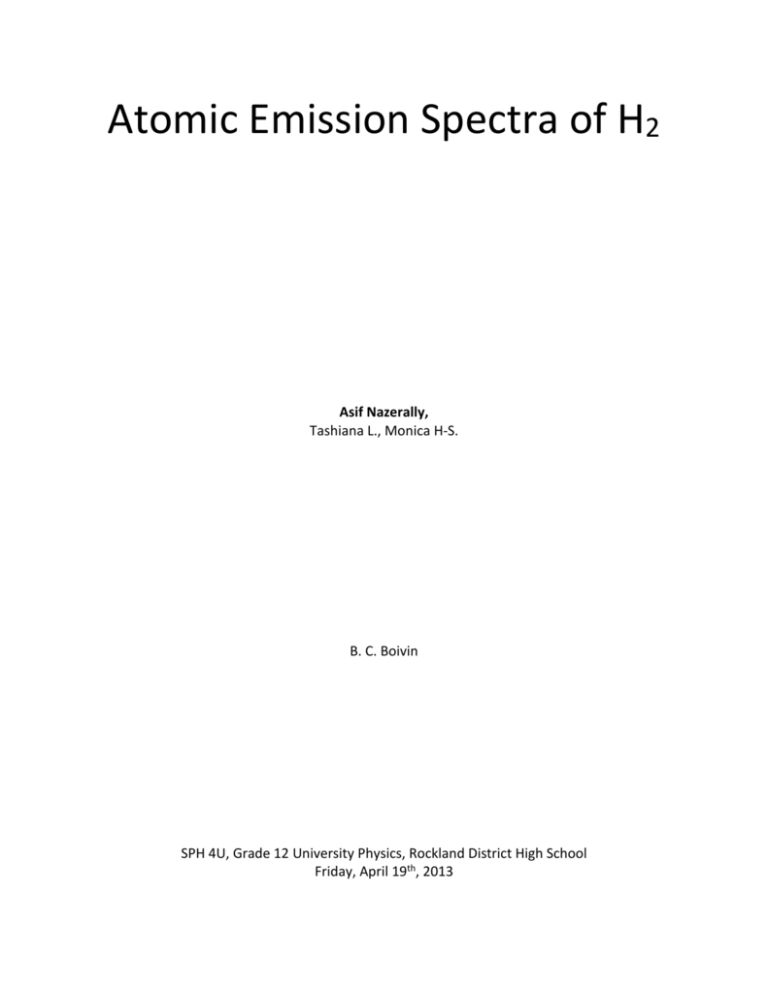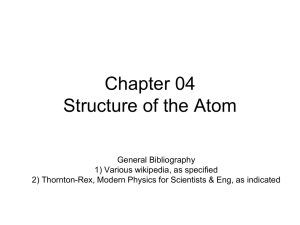Atomic Emission Spectra
advertisement

Atomic Emission Spectra of H2 Asif Nazerally, Tashiana L., Monica H-S. B. C. Boivin SPH 4U, Grade 12 University Physics, Rockland District High School Friday, April 19th, 2013 2 Introduction In this experiment, Niels Bohr’s atomic emission spectroscopy lab will be recreated for hydrogen gas with the equipment available. Atomic emission spectroscopy is a way to determine the amount of an element in a sample of light. The identity of the element is demonstrated by the wavelength, while the amplitude determines the number of atoms Figure 1. A picture of Niels Bohr (Simon, 2013). (Kkmurray, 2013). Niels Henrik David Bohr (see Figure 1) received a Nobel Prize for his contributions as a physicist to the better understanding of quantum mechanics and atomic Figure 2. Bohr model of hydrogen atom (JabberWok, 2007). structure (Manske, 2013). Bohr created the Bohr model (see Figure 2) which describes that electrons orbit around the nucleus of an atom, from attraction of electrostatic forces (Knott, 2013). Max Planck, theoretical physicist and creator of quantum theory, developed Planck’s constant (6.63x10-34 m2kg/s) which describes (on atomic level) how particles and waves behave (Hosch, 2006). He created the formula 𝐸 = Figure 3. Planck’s equation (Wittke, 2008). ℎ𝑣 to determine the energy of a photon (see Figure 3). The electromagnetic spectrum refers to the range that encompasses all frequencies of electromagnetic radiation, from radio waves (the weakest) all the way to gamma rays (the strongest). All but the visible light spectrum (see Figure 4) which ranges from the colour red (lowest frequency) to the colour violet (highest frequency) is 3 Figure 4. The visible light spectrum (Jones, 2012). invisible to the naked human eye (Newman, 2013). The empirical values of wavelength being used in this lab are, in nanometres, 400, 445, 475, and 650, for violet, indigo, teal and red, respectively (Madigan, 2011). The purpose of this lab is to measure quanta by reenacting Bohr’s atomic emission spectroscopy lab using a spectroscope and observing light from a discharge tube. 4 Theory 𝑐 = 𝑓λ ∆𝐸 = ℎ𝑓 Variables 𝑐 – Speed of light constant ∆𝐸 – Change in energy 𝑓 – Frequency ℎ – Planck’s constant λ – Wavelength Materials and Methods The materials and methods used were that of the SPH4U Physics class on Thursday, April 11, 2013. Figure 5. Lab setup (Hendrix-Sicard, 2013). 5 Results and Observations Table 1. Atomic emission spectra for H2. Spectral Line Wavelength Frequency (Hz) Colour (nm) Violet 440 6.82x1014 Blue 450 6.67x1014 Teal 500 6.00x1014 Red 670 4.48x1014 Calculations Calculations for Violet 𝑐 = 𝜆𝑓 𝑓= 𝑐 𝜆 𝑓𝑣𝑖𝑜𝑙𝑒𝑡 = 3.00𝑥108 4.4𝑥10−7 𝑓𝑣𝑖𝑜𝑙𝑒𝑡 = 6.82𝑥1014 𝐻𝑧 ∆𝐸 = ħ𝑓 ∆𝐸𝑣𝑖𝑜𝑙𝑒𝑡 = 6.63𝑥10−34 (6.82𝑥1014 ) ∆𝐸𝑣𝑖𝑜𝑙𝑒𝑡 = 4.52𝑥10−19 𝐽 Percentage of Error for Violet % 𝐸𝑟𝑟𝑜𝑟 = |𝐸𝑚𝑝𝑖𝑟𝑖𝑐𝑎𝑙 − 𝑀𝑒𝑎𝑠𝑢𝑟𝑒𝑑| 𝑥 100% 𝐸𝑚𝑝𝑖𝑟𝑖𝑐𝑎𝑙 % 𝐸𝑟𝑟𝑜𝑟 = |400 − 440| 𝑥 100% 400 % 𝐸𝑟𝑟𝑜𝑟 = 10.0% Change in Energy (J) 4.52x10-19 4.42x10-19 3.98x10-19 2.97x10-19 6 Discussion It was determined mathematically that the potential energy was 0.2J for the 50g weight, 0.9J for the 200g weight and 2.5J for the 500g weight. It was then determined experimentally that the kinetic energy was 0.0756J for the 50g weight, 0.4044J for the 200g weight and 1.0045J for the 500g weight, after twenty complete swings of the weights. These results appear to be inaccurate due to the large margin of possible errors, primarily that the pendulum lost a great deal of momentum and energy due to the instability of the pendulum. There were many possible sources of errors throughout this experiment. One of them would be that a lot of the potential energy is being lost through the pendulum. The reason is because the pendulum being used were quite old, therefore unstable and wobbly, and making the results of the experiment inaccurate. A possible solution to this would be to perhaps invest in more modern or reliable equipment or to clamp down the pendulum (but that would still leave the upright pole unstable). Another possible source of error would be the energy lost in the string. The string that the weight was hung from was tied around a metal ring, which was attached to the pendulum. When one of the heavier weights were used, the string was susceptible to sliding, which would render the results inaccurate since there is energy being lost. A solution to this issue would be to tape down or glue down the string to the metal ring. A third possible source of error could be that the desks that the pendulum stood on were uneven or crooked, thus making the swinging difficult to go one way and easier to go the other. To fix this issue, the desk’s legs could have been measured until they were made even. 7 All of these possible sources of error could have negatively affected the results of this experiment. Conclusion 8 Selected References Anome, T. (2013, April 3). Quantum. Retrieved April 18, 2013, from Wikipedia: http://en.wikipedia.org/wiki/Quantum Hendrix-Sicard, M. (2013, April 14). Physics 11/12 2012. Retrieved April 16, 2013, from Facebook: https://fbcdn-sphotos-d-a.akamaihd.net/hphotos-aksnc7/420934_534585586585237_1503022242_n.jpg Hosch, W. L. (2006, May 18). Planck's constant. Retrieved April 18, 2013, from Encyclopædia Britannica: http://www.britannica.com/EBchecked/topic/462917/Plancks-constant JabberWok. (2007, February 23). File:Bohr-atom-PAR.svg. Retrieved April 18, 2013, from Wikipedia: http://upload.wikimedia.org/wikipedia/commons/thumb/5/55/Bohr-atomPAR.svg/310px-Bohr-atom-PAR.svg.png Jones, C. (2012, November 27). Why Artificial Light Feels Wrong, Part 1. Retrieved April 18, 2013, from NextGenLite: http://nextgenlite.com/images/VisibleLightSpectrumGradientForWeb.jpg Kkmurray. (2013, February 27). Atomic emission spectroscopy. Retrieved April 18, 2013, from Wikipedia: http://en.wikipedia.org/wiki/Atomic_emission_spectroscopy Knott, T. (2013, March 20). Bohr model. Retrieved April 18, 2013, from Wikipedia: http://en.wikipedia.org/wiki/Bohr_model Madigan, J. (2011, November 15). What Wavelength Goes With a Color? Retrieved April 18, 2013, from National Aeronautics and Space Administration: http://scienceedu.larc.nasa.gov/EDDOCS/Wavelengths_for_Colors.html Manske, M. (2013, April 12). Niels Bohr. Retrieved March 18, 2013, from Wikipedia: http://en.wikipedia.org/wiki/Niels_Bohr Newman, P. (2013, March 21). Electromagnetic Spectrum. Retrieved April 18, 2013, from Goddard Space Flight Center: http://imagine.gsfc.nasa.gov/docs/science/know_l1/emspectrum.html Simon, A. (2013). Who's talking about Niel? Retrieved April 18, 2013, from Whotalking: https://lh4.googleusercontent.com/-dKL1Se5jv7I/S3opYzS21uI/AAAAAAAAAXQ/JcQY9Wv81c/s288/Niels%252520Bohr.jpg Wittke, J. H. (2008). Signals. Retrieved April 18, 2013, from Microanalysis: http://www4.nau.edu/microanalysis/Microprobe-SEM/Images/Equation01-1.jpg







